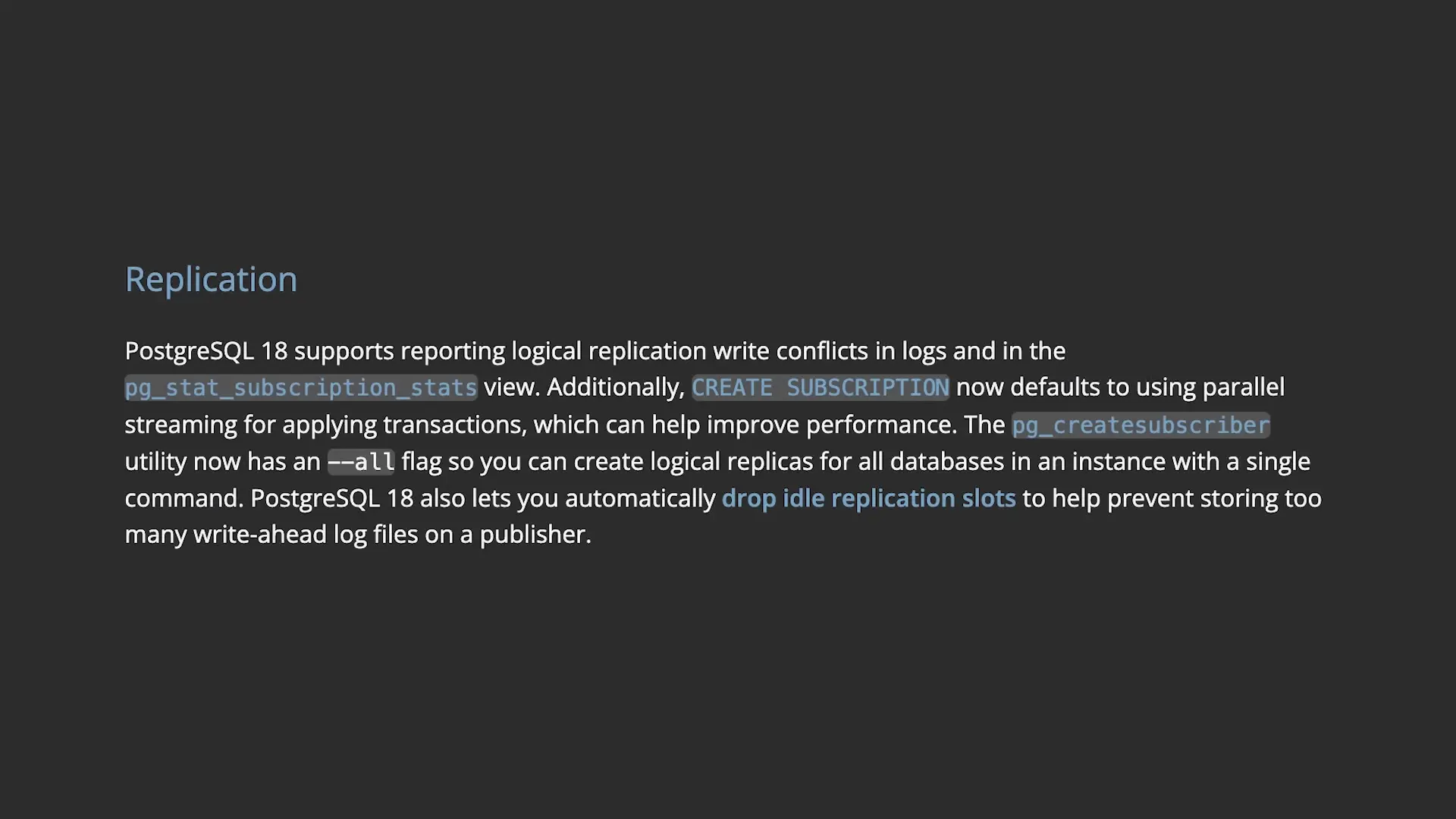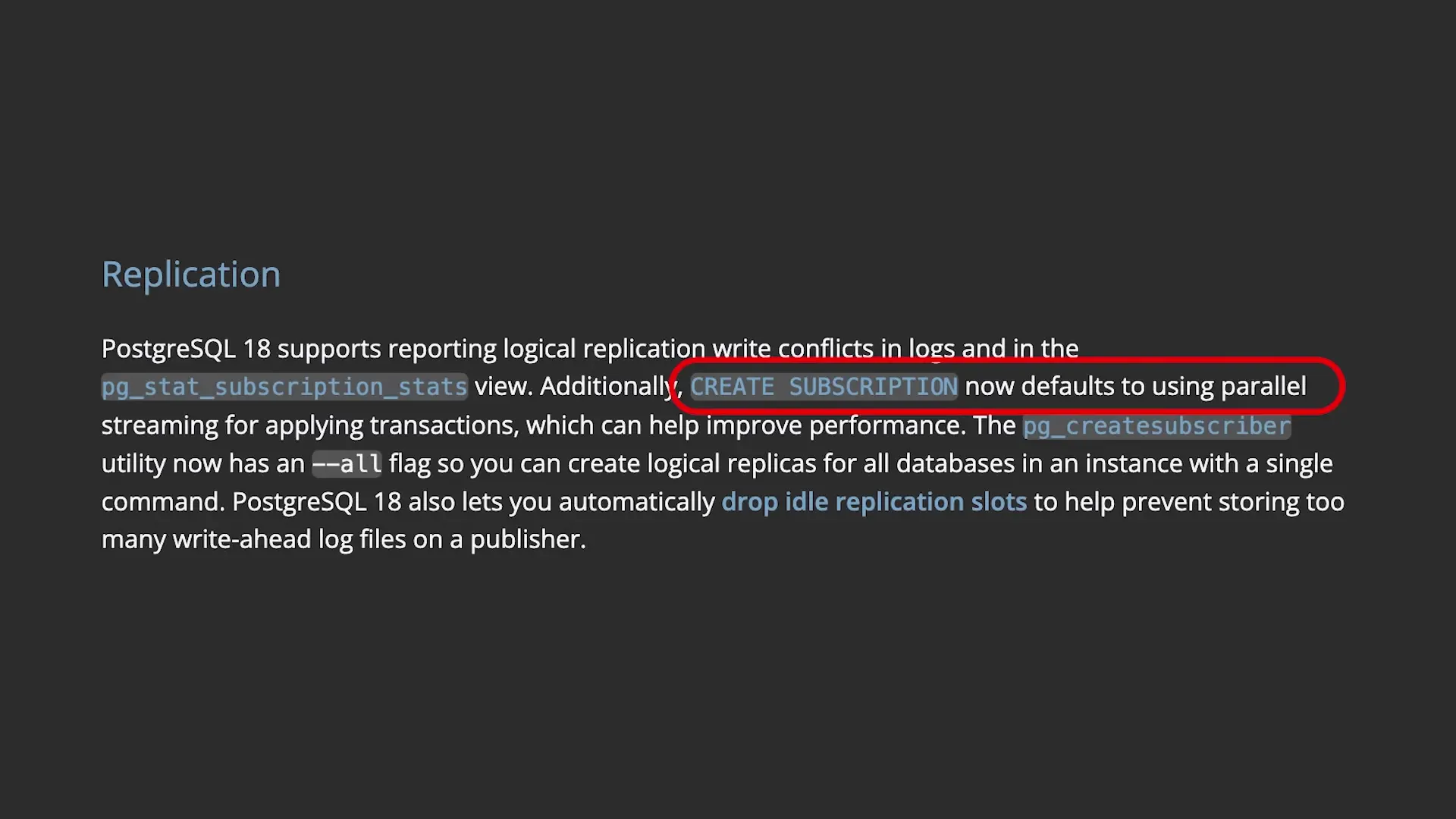
PostgreSQL 18 has arrived, marking one of the most substantial updates to the world's most advanced open-source database in recent years. This release packs an impressive array of improvements that touch every aspect of database operations - from dramatic performance enhancements to quality-of-life features that developers have been requesting for years.
Performance Revolution: Asynchronous I/O and Smarter Query Planning
The standout feature in PostgreSQL 18 is the brand-new asynchronous I/O subsystem. Rather than waiting for disk reads to complete one at a time, PostgreSQL can now issue multiple requests in parallel on supported systems. The impact is substantial - up to three times faster reads for certain workloads. This change alone makes upgrading worthwhile for performance-sensitive applications.
Query planning also received a major intelligence boost with the introduction of skip scans for multi-column indexes. Previously, PostgreSQL could only use an index efficiently if your query filtered on the first column. Now, even if your query only references secondary columns in a multi-column index, the database can still leverage that index. This reduces full table scans and offers developers greater flexibility when writing queries.
Painless Upgrades: Preserved Statistics and Faster Migration
Anyone who's upgraded PostgreSQL across major versions knows the pain: statistics reset, queries slow down until ANALYZE rebuilds everything, and downtime stretches longer than planned. PostgreSQL 18 addresses these longstanding pain points:
- Planner statistics can now be carried across upgrades, eliminating post-upgrade performance degradation
- pg_upgrade has been enhanced with better parallel checks for faster validation
- A new swap flag reduces downtime during the upgrade process
These improvements make the upgrade path from PostgreSQL 17 smoother than ever before, reducing a significant barrier to adoption for teams that need to stay current with database technology.
Developer-Friendly Enhancements
PostgreSQL 18 introduces several features that directly improve developer productivity and code quality:
- Generated columns now default to virtual (calculated on read rather than stored), saving storage and creating cleaner schemas
- OLD and NEW keywords are available in RETURNING clauses, making it easy to access both previous and updated values in a single operation
- The EXPLAIN command now shows buffer usage by default, providing richer statistics that help diagnose performance issues faster

-- Example of using OLD and NEW in RETURNING clause
UPDATE users
SET email = '[email protected]'
WHERE id = 123
RETURNING id, OLD.email as previous_email, NEW.email as updated_email;This capability is particularly valuable for auditing and logging systems, allowing developers to track changes without additional queries or complex triggers.
Modern Security Features
Security receives significant attention in PostgreSQL 18, with several important updates:
- OAuth 2.0 authentication support is now built-in, making integration with modern identity providers straightforward
- The legacy MD5 password method is officially deprecated, pushing users toward more secure SCRAM authentication or external OAuth
- New clusters enable page checksums by default, helping detect silent corruption in database files without extra configuration
These changes align PostgreSQL with contemporary security best practices and reduce the configuration burden on database administrators.
Improved Replication and Maintenance
For larger deployments, PostgreSQL 18 makes significant strides in replication reliability and maintenance automation:

- Automatic cleanup of idle replication slots prevents uncontrolled WAL (Write-Ahead Log) growth that could fill disks
- Logical replication now reports conflicts when data cannot be applied on the subscriber, improving transparency
- Table streaming now happens in parallel by default, accelerating large-scale replication operations

Vacuum processes have also been tuned to be more aggressive in freezing old tuples, reducing the chance of transaction ID wraparound issues that can bring databases to a halt if left unaddressed.
Comparison with Previous PostgreSQL Versions
To put PostgreSQL 18's advancements in context, it's worth comparing some key features with recent versions:
| Feature Area | PostgreSQL 16 | PostgreSQL 17 | PostgreSQL 18 |
|---------------------|--------------|--------------|---------------|
| I/O System | Synchronous | Synchronous | Asynchronous |
| Index Usage | Basic | Improved | Skip Scans |
| Authentication | SCRAM/MD5 | SCRAM/MD5 | OAuth 2.0 |
| Upgrade Experience | Stats Reset | Stats Reset | Stats Preserved |
| Generated Columns | Stored | Stored | Virtual Default |While PostgreSQL 15 and 16 introduced important features like SQL/JSON improvements and performance optimizations, PostgreSQL 18 represents a more fundamental shift in how the database engine operates, particularly with its asynchronous I/O system and improved query planning capabilities.
Should You Upgrade to PostgreSQL 18?
With all these improvements, the case for upgrading to PostgreSQL 18 is compelling for most users. The performance gains alone justify the upgrade, while quality-of-life features make development more productive. If you're already on PostgreSQL 17, the upgrade path is smoother than ever before.
- Applications with heavy read workloads will benefit immediately from asynchronous I/O
- Development teams will appreciate the improved query debugging and RETURNING clause enhancements
- Operations teams will value the more reliable replication and maintenance features
- Security teams will welcome the modern authentication options and deprecated legacy methods
Conclusion
PostgreSQL 18 represents a significant leap forward for the world's most advanced open-source database. With faster queries, smarter indexes, easier upgrades, and modern security features, this release addresses pain points across the spectrum of database usage. Whether you're a developer, database administrator, or system architect, PostgreSQL 18 offers compelling reasons to upgrade sooner rather than later.
These improvements reinforce PostgreSQL's position as a leading database solution that continues to evolve with the needs of modern applications while maintaining its commitment to reliability, security, and performance.
Let's Watch!
PostgreSQL 18: The Game-Changing Features Developers Need to Know
Ready to enhance your neural network?
Access our quantum knowledge cores and upgrade your programming abilities.
Initialize Training Sequence